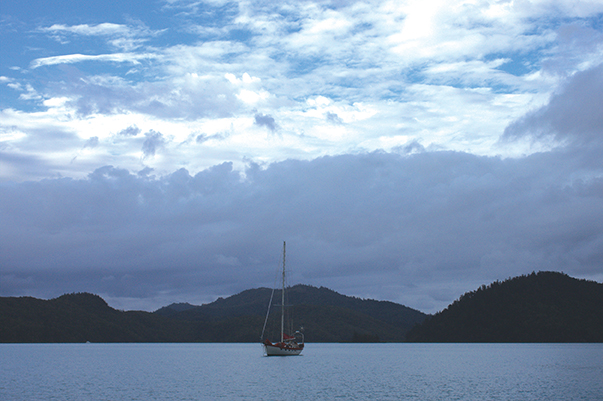After selling their Dufour 35, Namani, the author and her family enjoy a final month aboard during the delivery along the East Australian Coast (published June 2016)
Sailing in Australia can be a lot of things; blue water passagemaking or day hopping, downwind daydreaming or head bashing beats to windward. The only certainty is the element of surprise. After two months of sailing the coast of New South Wales, we headed to tropical Queensland, steeling ourselves for a sentimental goodbye. It was time to sell our trusty sloop, Namani, and time to think about heading home after nearly three magical years of cruising the Pacific. Sailing into Brisbane’s Moreton Bay, where we planned to sell our boat, had been our last hurrah—or so we thought.
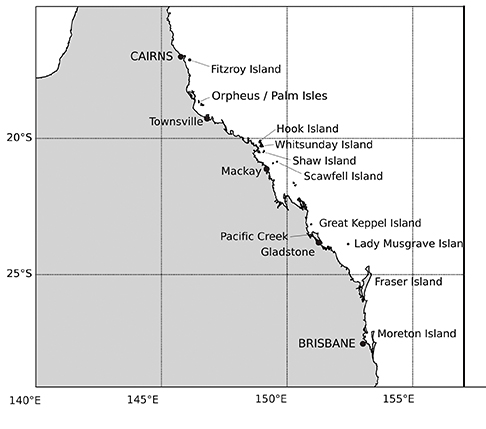
In preparing the sales listing for our 1981 Dufour 35, we had tacked on a comment: “will deliver.” During the month we spent in Brisbane awaiting a sale, we’d all but given up on the possibility of extending our time aboard. But along came Janet with an offer we couldn’t refuse: a good price for the boat, along with a deal that gave us two months to deliver the sloop to her home port of Cairns, 800 miles to the north.
The only catch was that the timing, March and April falls into the shoulder cyclone season. Over the past three years, we’d been avoiding cyclones like the plague, taking thousand-mile detours to stay out of their way. Australian sailor friends we asked advice of, however, had no reservations about sailing north. “Oh, you’ll be right!” they declared in their happy-go-lucky way. The chances of a cyclone were small, they said, and there are plenty of creeks to seek shelter in along the way. Even so, we decided to wait until April before departing to reduce the statistical risk of encountering a cyclone. Our excitement grew as departure day approached, thanks to the promise of enticing cruising grounds ahead. Much as we’d enjoyed Australia thus far, East Coast sailing had consisted mostly of long dashes between the few easily accessed harbors along an uninviting coastline. By sailing on to Cairns, we’d be exploring real cruising grounds again: island groups with nooks and crannies that invite a sailor to linger and explore.
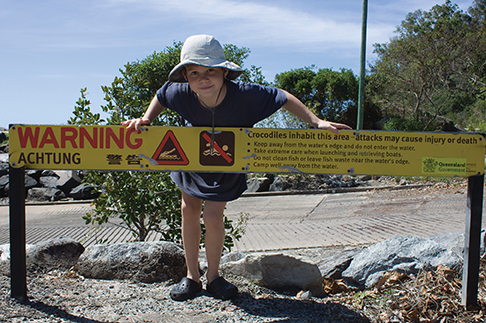
The journey begins
And so we set out on a month-long trip that was equal parts ocean passagemaking and coastal cruising, alternating between overnight passages and easy days at anchor in choice locations. Theoretically, a boat can day-trip all the way up the Queensland coast, but with “only” five weeks to enjoy it all, we decided to start the trip with a 72 hour / 300 mile run to make a dent in the overall distance. Thanks to prevailing southeasterlies, finding a window to head north is an easy enough exercise. We set off in early April, delighted to have one last encore at sea.
It was a relief to leave the single-digits shallows of Brisbane’s Moreton Bay behind and head into open waters, where our main navigational challenges were monitoring shipping traffic and riding a contrary current. Six foot seas from the stern quarter reminded our stomachs that we’d spent too much time on land, but we knew that initial three day passage would get us into the swing of things again. On a goodbye sail, the brush of sentimentality paints everything in a special light: the exhilaration of the sails filling, the grandeur of a solitary watch under the southern night sky, and yes, even the feeling of a queasy stomach.
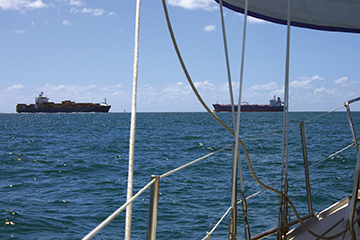
The outside route
Given our schedule, we opted for the outside route around the long finger of Fraser Island, which doesn’t hold the same appeal as smaller islands farther north. This put us right into the teeth of the current. Progress slowed to a two knot crawl—until the moon pulled the tide around to a more favorable direction and bumped our speed up to as high as seven knots. Queensland’s central coast has some of the most extreme currents and tides observed Down Under, the latter topping out at six meters around Mackay. We quickly learned not to despair when Namani turtled along, knowing she’d be speeding ahead a few hours later.
The difficulty lay in deciding how close to cut the corner of Fraser Island. Too close, and the current would only intensify. Too far, and we’d be shoulder-to shoulder with the steady parade of freighters paralleling the coast. Eventually, we decided on tiptoeing along the 100 meter contour about 10 miles off Fraser Island and spent the night keeping a sharp eye out for steaming lights. Having our AIS receiver to help predict their movements was a welcome novelty. For most of our Pacific crossing, the AIS was of little use since so many ships and fishing boats operate without it. Off Queensland, just about every vessel transmitted a signal we could pick up from as much as 30 miles away, and there were only a handful of smaller vessels without AIS to track.
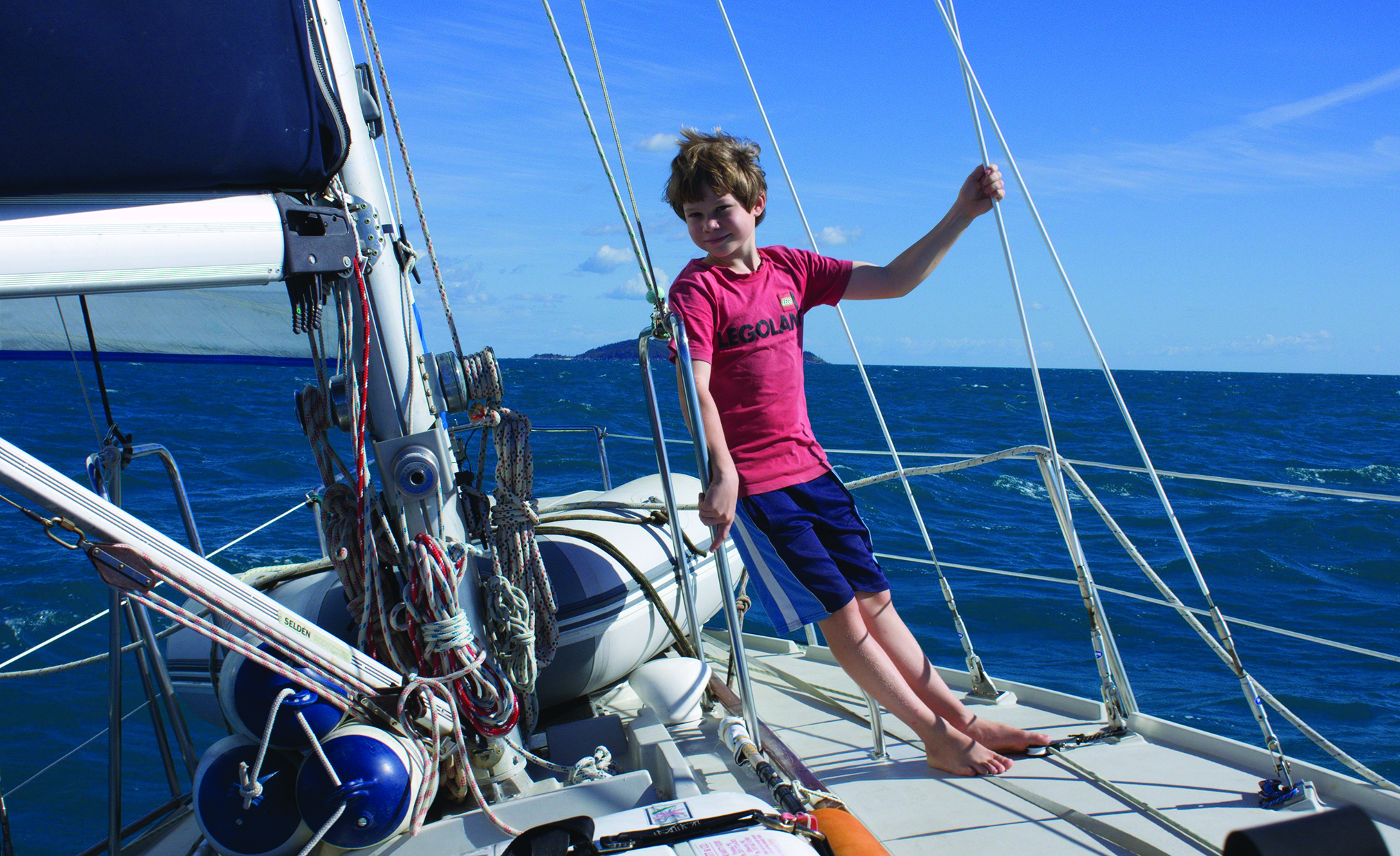
We’d spent so long sailing wide open swaths of ocean that traveling along an extended coastline felt strange. On one hand, we felt very much in blue water mode, with the open ocean on our right and a four hour schedule of watchkeeping day and night. To port, however, lay the slumbering coast, and the depth sounder never dropped below one hundred feet. It was a confusing, “so close yet so far” sensation. At one point 13 miles offshore, Namani was overwhelmed by the scent of eucalyptus wafting offshore like the mother of all throat remedies—a special memory to add to a collection rich in sights, sounds and experiences.
With sunny skies, balmy temperatures, and good wind, our final voyage was off to a good start. The only disappointment was having to bypass Lady Musgrave Island, an enticing coral cay with a navigable lagoon. Well, it would be navigable if the sun had been overhead, but not at sunset, when we sailed past. The good news was that we had reached an important milestone: the southernmost end of the Great Barrier Reef, which begins far offshore and squeezes closer to the coast farther north.
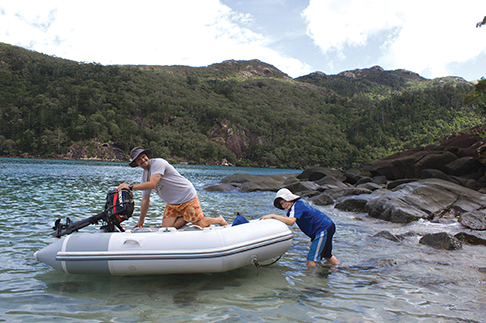
Weather Watch
The bad news was the latest forecast. Less than a week after weather authorities like Bob McDavitt declared a definitive end to cyclone season, a low built over the Solomon Islands that would eventually spawn Cyclone Ita and hurl it right at the Queensland coast. Although the storm’s development was still uncertain at that time, we went on red alert. With a period of strong southerlies forecast to blow in the intervening time, our best chance to seek shelter would be over the next couple of days while pleasant conditions prevailed. By the time we anchored off Great Keppel Island the next morning, we knew we wouldn’t be settling in for long. That was a pity, given the island’s gorgeous beach, green hills, and quiet anchorage. A massive eagle’s nest in a treetop near the beach was the only sign of habitation in this echo of Eden. We spent two nights in this lovely location, playing on the beach but keeping our dips in the water brief. That’s the agony of cruising in Australia; the ever-present threat of sharks, crocodiles, and deadly jellyfish tends to spoil the attraction of the sparkling tropical waters. We settled for beach combing instead—between downloading weather reports, that is.
The only thing the various forecast models agreed on was that a cyclone would develop and strike the north/central Queensland coast—somewhere. Some models had the cyclone dissipating over land, while others had it bouncing down the coast, right at Namani. In any scenario, heading any farther north would be folly. We decided to hunker down amidst the mangroves of Pacific Creek, a half-day sail south of Great Keppel Island. Timing our arrival carefully for high tide, we eased our six foot draft over the bar at the creek’s entrance (charted at three feet at low water). When depths dropped off to a healthy twenty-plus feet, we set our anchor in the muddy bottom of the creek. Then the waiting began.
It was a week to be endured more than enjoyed. We were sitting ducks to the mosquitoes and no-see-ums of the creek, and our son Nicky proved the tastiest of us all, racking up 100 bites within 48 hours despite doses of insect repellent and netting on all hatches. We took to wearing pants and long sleeves despite the heat and burned mosquito coils all day, every day. If nothing else, we made good progress on our pet projects: my husband Markus was busy programming a weather data program for sailors called Slocum (https://github.com/akleeman/slocum), Nicky made a 3D model of our boat (with a little home schooling on the side) and I had plenty of time to write.
A week after our arrival in Pacific Creek, Cyclone Ita pounded the northern Queensland coast near Cooktown, then swept south, curving out to sea 100 miles east of our location. The worst we registered deep in Pacific Creek was an occasional burst of 40 knot winds. Had the cyclone hit more directly, we were confident that we would have weathered it well in the narrows of the creek. The experience lent a touch of symmetry to our three year Pacific cruise: when we initially set out on the trip from Maine, Hurricane Irene put a similar monkey wrench in our plans.
With the coast finally clear, we were eager to press on to the real highlight of our cruise, the Cumberland Islands. After a brief reprovisioning stop in nearby Keppel Bay (the only such stop during the five week trip), we slipped back into passagemaking mode and made a quick thirty six hour run to Scawfell Island. Another night of stars, another day to contemplate our futures. We savored every moment, in no rush to leave our comfortable home and the quiet sailing life.
From passagemaking to coastal cruising
Or the quiet motorsailing life, as things turned out, given light, fluky wind from the east. Now inside the Great Barrier Reef, we had an easy time staying clear of shipping, which followed a well-defined lane that we paralleled at a safe distance. After so many miles of following a relatively bland coast, it was a joy to sail among islands and islets again. We ticked off one after another until the following sunset, when Namani slipped in to the anchorage at Scawfell Island and settled in for the first of two nights. The orange light of Mars rose over the hulk of the island, the Southern Cross hung tenuously between the hooves of the Centaur, and Scorpio crashed the party, too, climbing high into the sky along with the flash of a shooting star.
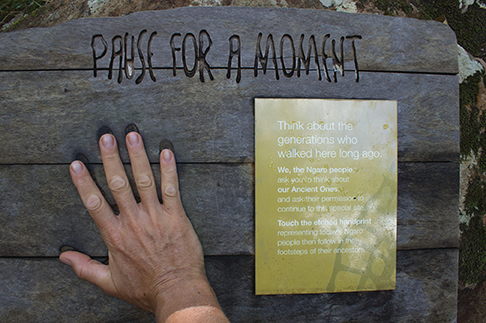
Over the next week, we switched back to day-hopping mode. Short daylight hours in these tropical latitudes kept us on our toes as we planned a route that would take us from Scawfell and Shaw Islands in the less-frequented southern Cumberland Islands to the Whitsundays farther north. Though small in area, the Whitsundays are the most frequented cruising grounds in Australia. The anchorages were packed with dozens of boats as a period of troughy weather settled over the area. We sat it out in Cid Harbour, where pines carpet the hillsides and sea eagles pluck fish straight from the water. Two fjord-like bays on Hook Island offer good protection, as well. At lovely Nara Inlet, we hiked a short path to a cave with Aborignal rock art, then moved over to Macona Inlet for a little more solitude from the Easter vacation crowds. Having visited the gorgeous white sands of Whitehaven Beach some years earlier while chartering, we decided to give it a miss this time around and concentrate on our next overnight trip to places off the beaten path.
North of the Whitsundays, the coast takes a northwest bend, making for a more pleasant wind angle under prevailing southeasterlies. Sailors in Maine go Down East; in Queensland, it’s Up West as we set of course of 300 degrees toward the setting sun for yet another overnight passage. The rolly downwind sailing reminded us of our trade wind passage from the Galapagos Islands to the Marquesas—except that we had a continent on one side, the world’s longest reef on the other, and only eighty feet of water under the keel.
Once underway under a new moon, we were reminded of how much light the stars provide—including our old friend the Big Dipper, peeking above the horizon. Thanks to the stars and several beacons, we had the visual reference of the mainland coastline and low-lying islands—a welcome sanity check for sailors like us who are never truly comfortable relying on electronic charts. We’d been warned against night sailing off shipping ports like Gladstone and Townsville, but the only real traffic we encountered was off Abbott Point, where seven ships lay at anchor waiting to load up with coal.
Daylight hours were peppered with Coast Guard bulletins coming through on the VHF, including weather bulletins and warnings of live ammunition exercises at Rattlesnake Island. But we on Namani carried on unperturbed in our own quiet bubble, just the three of us and the faithful boat that had carried us two-thirds of the way around the world since our earliest days in the Mediterranean. The days of that bubble were numbered, so we made sure to appreciate every quiet minute, every peaceful view.
Halfway between the Whitsundays and Cairns lies an isle group known as the Palm Isles, the perfect place for a last stopover. We passed one small resort and a research station before grabbing one of two visitor’s moorings in Pioneer Bay on Orpheus Island. After the relative crowds of the Whitsundays, it was a pleasure to have an anchorage to ourselves once again, and we enjoyed our solitude for another two days.
That left a mere 120 miles to our final destination. We couldn’t have asked for much more for our last overnight passage aboard Namani; calm seas and steady wind to fill the sails, plus a tropical landscape to fill our senses. We drank it all in, eking everything we could out of the dying wind before switching the motor on in the wee hours of morning. In contrast to the relatively open waters of our previous passages, this one had Namani tip-toeing past tiny islets and reefs in an area where the Great Barrier Reef creeps close to the coast. Detailed charts and a series of beacons guided us through the night until we homed in on Fitzroy Island’s powerful light. At dawn, we rounded Cape Grafton and gained our first view of Cairns.
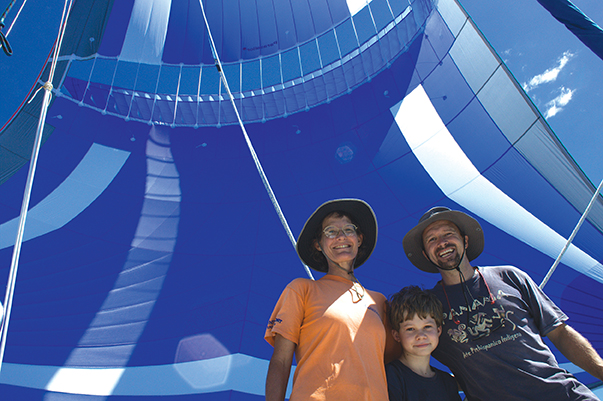
Arrival was a bittersweet affair. We were sad to face the conclusion of a wonderful chapter in our lives and to say goodbye to the floating home that had brought us so far. But it was a time to celebrate as well. With so many magical experiences to look back over, we just couldn’t complain, least of all after this unexpected delivery cruise along east Australia’s most scenic coast. We were heartened to know that Namani would now reside in a beautiful corner of the world with an energetic owner who will lead her over many romps in her watery playground. And as for us, well, the end of one adventure signals the start of another. Who knows what it will be?
Nadine Slavinski is a parent, sailor, and Harvard-educated teacher. She recently returned from a three year cruise aboard her 35 foot sloop, having sailed from Maine to Australia together with her husband and young son. She is the author of three sailing guides: Pacific Crossing Notes: A Sailor’s Guide to the Coconut Milk Run, Cruising the Caribbean with Kids and Lesson Plans Ahoy: Hands-On Learning for Sailing Children and Home Schooling Sailors. Her next project is The Silver Spider, a novel of sailing and suspense. See nslavinski.com.















